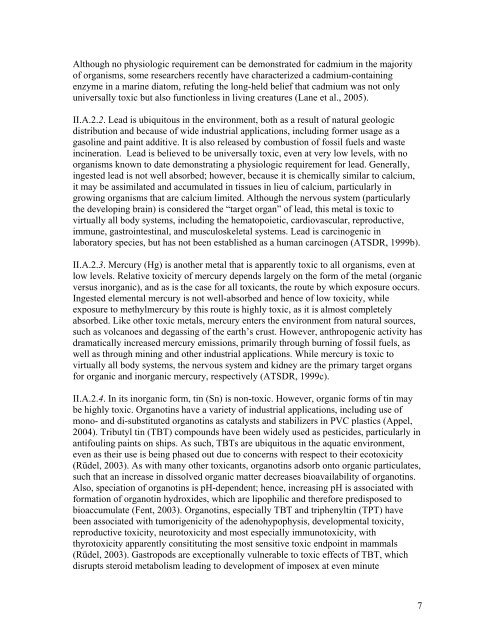Volume III, Appendices EM - National Marine Fisheries Service ...
Volume III, Appendices EM - National Marine Fisheries Service ...
Volume III, Appendices EM - National Marine Fisheries Service ...
Create successful ePaper yourself
Turn your PDF publications into a flip-book with our unique Google optimized e-Paper software.
Although no physiologic requirement can be demonstrated for cadmium in the majority<br />
of organisms, some researchers recently have characterized a cadmium-containing<br />
enzyme in a marine diatom, refuting the long-held belief that cadmium was not only<br />
universally toxic but also functionless in living creatures (Lane et al., 2005).<br />
II.A.2.2. Lead is ubiquitous in the environment, both as a result of natural geologic<br />
distribution and because of wide industrial applications, including former usage as a<br />
gasoline and paint additive. It is also released by combustion of fossil fuels and waste<br />
incineration. Lead is believed to be universally toxic, even at very low levels, with no<br />
organisms known to date demonstrating a physiologic requirement for lead. Generally,<br />
ingested lead is not well absorbed; however, because it is chemically similar to calcium,<br />
it may be assimilated and accumulated in tissues in lieu of calcium, particularly in<br />
growing organisms that are calcium limited. Although the nervous system (particularly<br />
the developing brain) is considered the “target organ” of lead, this metal is toxic to<br />
virtually all body systems, including the hematopoietic, cardiovascular, reproductive,<br />
immune, gastrointestinal, and musculoskeletal systems. Lead is carcinogenic in<br />
laboratory species, but has not been established as a human carcinogen (ATSDR, 1999b).<br />
II.A.2.3. Mercury (Hg) is another metal that is apparently toxic to all organisms, even at<br />
low levels. Relative toxicity of mercury depends largely on the form of the metal (organic<br />
versus inorganic), and as is the case for all toxicants, the route by which exposure occurs.<br />
Ingested elemental mercury is not well-absorbed and hence of low toxicity, while<br />
exposure to methylmercury by this route is highly toxic, as it is almost completely<br />
absorbed. Like other toxic metals, mercury enters the environment from natural sources,<br />
such as volcanoes and degassing of the earth’s crust. However, anthropogenic activity has<br />
dramatically increased mercury emissions, primarily through burning of fossil fuels, as<br />
well as through mining and other industrial applications. While mercury is toxic to<br />
virtually all body systems, the nervous system and kidney are the primary target organs<br />
for organic and inorganic mercury, respectively (ATSDR, 1999c).<br />
II.A.2.4. In its inorganic form, tin (Sn) is non-toxic. However, organic forms of tin may<br />
be highly toxic. Organotins have a variety of industrial applications, including use of<br />
mono- and di-substituted organotins as catalysts and stabilizers in PVC plastics (Appel,<br />
2004). Tributyl tin (TBT) compounds have been widely used as pesticides, particularly in<br />
antifouling paints on ships. As such, TBTs are ubiquitous in the aquatic environment,<br />
even as their use is being phased out due to concerns with respect to their ecotoxicity<br />
(Rüdel, 2003). As with many other toxicants, organotins adsorb onto organic particulates,<br />
such that an increase in dissolved organic matter decreases bioavailability of organotins.<br />
Also, speciation of organotins is pH-dependent; hence, increasing pH is associated with<br />
formation of organotin hydroxides, which are lipophilic and therefore predisposed to<br />
bioaccumulate (Fent, 2003). Organotins, especially TBT and triphenyltin (TPT) have<br />
been associated with tumorigenicity of the adenohypophysis, developmental toxicity,<br />
reproductive toxicity, neurotoxicity and most especially immunotoxicity, with<br />
thyrotoxicity apparently consitituting the most sensitive toxic endpoint in mammals<br />
(Rüdel, 2003). Gastropods are exceptionally vulnerable to toxic effects of TBT, which<br />
disrupts steroid metabolism leading to development of imposex at even minute<br />
7
















